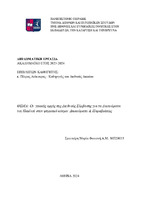Οι γενικές αρχές της Διεθνούς Σύμβασης για τα Δικαιώματα του Παιδιού στον ψηφιακό κόσμο : δικαιώματα & παραβιάσεις

View/
Keywords
Διεθνής Σύμβαση για τα Δικαιώματα του Παιδιού ; Δικαίωμα στη μη διάκριση ; Βέλτιστο συμφέρον του παιδιού ; Δικαίωμα στην ζωή, την επιβίωση και την ανάπτυξη ; Δικαίωμα του παιδιού να ακουστεί ; Παραβίαση ; Ψηφιακός κόσμοςAbstract
Today's students are no longer the individuals for whom our educational system was originally designed. Marc Prensky aptly referred to them as "Digital Natives." The involvement of minors in the digital world has highlighted the need to protect their rights in this space. The International Convention on the Rights of the Child was initially focused on protecting children in the physical world, and certainly, in 1989, no one could have predicted the rapid technological advancements or how this technology could, in some cases, violate children's rights.
The completion of this study was structured into five chapters. The first chapter addresses the right to non-discrimination (Article 2) through the lens of the right to education. This chapter refers to the various forms of digital exclusion that minors face depending on their country of origin, income criteria, gender, or even their health status. The issue of discrimination and inequality became even more prominent during the COVID-19 pandemic. General Comment No. 25 calls on states to ensure that digital divides are bridged. The chapter continues with an examination of the example of Greece concerning digital education.
The second chapter discusses the best interests of the child (Article 3) as the primary consideration in all decisions affecting children in both public and private spheres. This is a complex concept, the content of which should be determined on a case-by-case basis, taking into account the child’s age and maturity level. The chapter then addresses the issue of children's privacy in the digital world, providing a historical approach to privacy, and references the U.S. federal law COPPA as well as the European framework before and after the GDPR (General Data Protection Regulation) for personal data.
The third chapter explores the child’s "inherent" right to life, survival, and development (Article 6) and the new forms of online violence that can violate this right. It then analyzes cases of cyberbullying, online hate speech among minors, and minors' profiles on social media. Additionally, it covers instances of sexual abuse online, which can even take the form of child pornography. In cases of sexual abuse, it includes sexting (the exchange of sexually explicit messages and photos), sextortion (sexual extortion), and grooming (online enticement). Furthermore, it discusses another form of cyberattack: phishing attacks.
The fourth chapter addresses a new fundamental right under the Convention on the Rights of the Child, specifically the right of the child to be heard (Article 12) and examines how this right is exercised in the digital world. The Lundy Model clarifies the four necessary factors for facilitating the participation of minors in decision-making processes. The case of Greta Thunberg is mentioned as a representative example of a young person acting to amplify the voices of youth. The fifth and final chapter of this study provides a summary of the role and activities of the Greek Ombudsman for Children.


